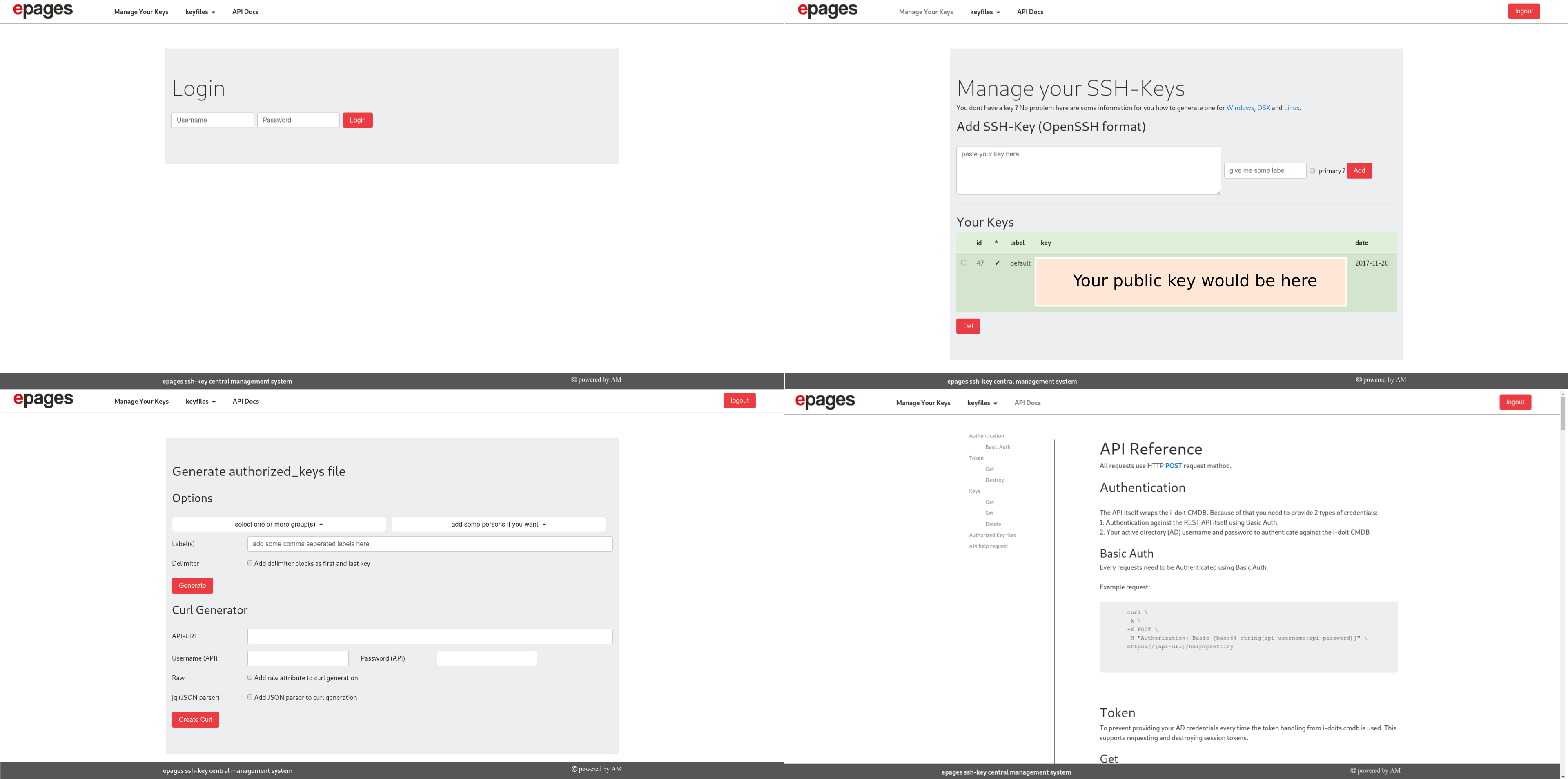In the previous post we described How to easily manage SSH keys.
Now it’s time to implement the backend to be able to store, request and filter our ssh-keys and create authorized_keys files.
If you’ve read my other blog posts, you know I’m a big fan of Golang. So it’s no surprise that both, the API and the frontend are written in Golang. I’ve also written and do maintain a Golang client library impementation for i-doit that will be used here.
Before we start, this post does not touch the basics of implementing a REST API. It would be too long to read, so it just covers the specifics of our use case. If it’s your first REST API implementation, you may want to look at some tutorials and/or frameworks on the internet. I’ve also written a small library for this purpose where you can find some basic examples implementing a simple HTTPS GET handler. In our case all data payloads are provided by the user via HTTP(S) POST.
Let’s concentrate on the CMDB-specific parts.
To not mess with authentication we use the authentication of the i-doit API and just pass username and password through (or create a token). We now need to get the user id. The following simple trick helps us here:
a, err := goidoit.NewLogin(URL, APIKEY, USERNAME, PASSWORD)
if err != nil {
// put your error handling here
}
data, _ := a.Version()
// the version contains also user information we can use
id, err := strconv.Atoi(data.Result[0]["login"].(map[string]interface{})["userid"].(string))
if err != nil {
// put your error handling here
}
To store our ssh keys we can use the following structure:
// SSHKey contains ssh key information
type SSHKey struct {
ID int `json:"id"`
Key string `json:"key"`
Label string `json:"label"`
Primary string `json:"primary"`
Date string `json:"date"`
}
and get the SSH keys for the user:
keyData, err := a.GetCat(id, "C__CATG__CUSTOM_FIELDS_SSHKEYS")
if err != nil {
// put your error handling here
}
If you never worked with i-doit before, the C__CATG__CUSTOM_FIELDS_SSHKEYS" is a category index used to find specific categories.
You can find them all in the JSON-RPC API documentation from idoit.
C__CATG__CUSTOM_FIELDS_... is the category index of the custom fields we created in the first post.
We also need a specific field index used for our data fields within our category.
You will find it on the configuration page of the i-doit CMDB where we created the custom category.
There you can find all field indexes under show technical configuration.
The indexes listed there are just examples so don’t try to use them.
Text fields starts with f_text_c_ and our yes-no-field is a so called dialog field and starts with f_dialog_c.
Now just loop over the result and map them to fit the structure.
var sshKeys []SSHKey
if keyData.Result != nil {
for _, v := range keyData.Result {
var key, date, label, primary string
// use the field specific index and map them to the correct struct fields
// ssh-key - textfield
if v["f_text_c_1506425983066"] != nil {
key = v["f_text_c_1506425983066"].(string)
}
// date - textfield
if v["f_text_c_1508155981380"] != nil {
date = v["f_text_c_1508155981380"].(string)
}
// label - textfield
if v["f_text_c_1510835561457"] != nil {
label = v["f_text_c_1510835561457"].(string)
}
// primary - yes-no-field
if v["f_dialog_c_1510835574647"].(map[string]interface{})["title"] != nil {
primary = v["f_dialog_c_1510835574647"].(map[string]interface{})["title"].(string)
}
// id needs to be int so we convert it
id, err := strconv.Atoi(v["id"].(string))
if err != nil {
// put your error handling here
}
// and finaly put our SSHKey struct into our list
sshKeys = append(sshKeys, SSHKey{id, key, label, primary, date})
}
}
Don’t be confused by lines like this:
v["f_dialog_c_1510835574647"].(map[string]interface{})["title"].(string)
The .(map[string]interface{}) is a concept in Golang called type assertions that just assigns a specific type to an interface.
In our case we assign map[string]interface{} to it which is similar to an associative array where the key is a string and the value itself is also just interface{}.
Then the index title is called, and the string type is assigned to the interface.
I mean it’s “similar to arrays”, because Golang does not often make use of arrays, it has slices.
If you want to add a key to a user, you can do this more or less the same way:
keyData := struct {
SSHKey string `json:"f_text_c_1506425983066"`
Date string `json:"f_text_c_1508155981380"`
Label string `json:"f_text_c_1510835561457"`
Primray string `json:"f_dialog_c_1510835574647"`
Desc string `json:"description"`
}{key, date, label, primary, ""}
_, err = a.CreateCat(id, "C__CATG__CUSTOM_FIELDS_SSHKEYS", keyData)
if err != nil {
// put your error handling here
}
This adds a new SSH key.
Now we know everyting to implement specific filters and combinations e.g:
- selecting a group from our CMDB, getting all members, and then getting all SSH keys (and maybe filter them)
- adding people easily to existing querys that already contain one or more groups
- of course filtering the label, date, primary or whatever is no problem.
Also curl can be used against our API.
An example may look like this:
curl -X POST -H "Authorization: Basic $(echo 'user:password' | base64)" \
-d "[]group=some Team" \
-d "[]group=some other Team" \
-d "[]add=some additional user" \
-d "[]label=mylabel1" \
-d "[]label=mylabel2" \
-d "raw=true" \
https://ssh-api-url/key/export | jq -r '.["authorized_keys"]'
The []group array is used to add groups to our query []add to simply add persons and []label lets us filter for specific labels.
Since everything is returned as JSON we can use a CLI tool called jq to parse the whole stuff.
Using curl it is easy to implement a bash script wrapper to simplify the command line usage.
From here on we should have a working API as a good foundation to create a frontend. It’s now up to you to implement the API into a fully grown frontend service. But to give you some hints how this can look like, here is a picture of what I did:
Happy coding!


